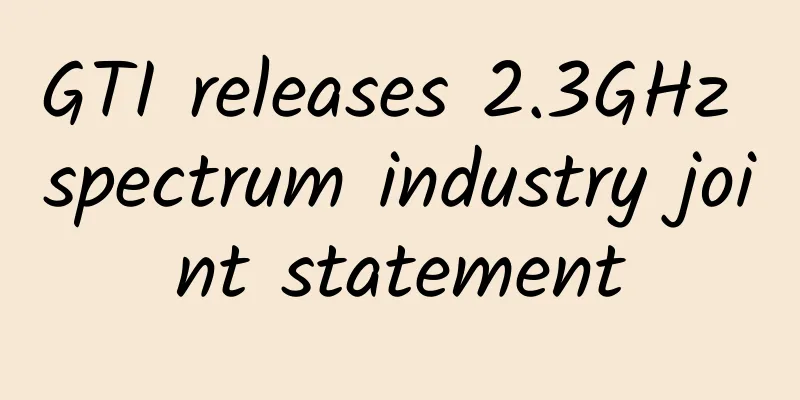Wi-Fi 6 certification, here are 6 issues worth paying attention to!

|
This article is reproduced from Leiphone.com. If you need to reprint it, please go to Leiphone.com official website to apply for authorization. It has been nearly a year since the announcement of Wi-Fi 6. During this year, there have been endless news about Wi-Fi 6, but those are just some scattered news related to Wi-Fi 6. And just yesterday, September 16, 2019, Wi-Fi 6 has made further progress. The Wi-Fi Alliance announced on its official website the official launch of the Wi-Fi CERTIFIED 6™ certification program. So, what is Wi-Fi 6? What are its advantages? In what scenarios will it be used? Will the Wi-Fi 6 certification plan be popularized to users? In response to these questions, Leifeng.com (official account: Leifeng.com) sorted out six questions about Wi-Fi 6 and introduced them one by one as follows. What is Wi-Fi 6? Wi-Fi 6, as the name implies, is the sixth generation of Wi-Fi. On October 3, 2018, the Wi-Fi Alliance officially incorporated Wi-Fi based on the IEEE 802.11ax standard into the regular army, making it the sixth generation of Wi-Fi technology, namely Wi-Fi 6. It is worth noting that before finalizing Wi-Fi 6, the Wi-Fi Alliance first announced a new naming system, which replaced the original complex technical naming method with numbers in chronological order (which is also the order of performance strength). Users can identify the performance of Wi-Fi standards, including speed, throughput, user experience, etc., by the size of the numbers. The details are as follows:
Regarding Wi-Fi CERTIFIED 6, Edgar Figueroa, president and CEO of Wi-Fi Alliance, said that Wi-Fi CERTIFIED 6 is ushering in a new era of Wi-Fi, building on the core characteristics of Wi-Fi to provide users with better environmental performance and service providers with greater network capacity to improve customer coverage. Compared with Wi-Fi 5, what are the improvements of Wi-Fi 6? According to official introduction, the capacity of Wi-Fi 6 is almost four times that of Wi-Fi 5, and Wi-Fi 6 can provide high-performance infrastructure and optimized connections for all devices on the network at the same time, improving densely connected Wi-Fi environments. Specifically, public data shows that both Wi-Fi 6 and Wi-Fi 5 support 20/40/80/80+80/160MHz frequency bands, but Wi-Fi 5 only involves the 5GHz frequency band, while Wi-Fi 6 covers the 2.4GHz and 5GHz frequency bands, covering both low-speed and high-speed devices. In terms of modulation mode, Wi-Fi 5 is 256-QAM and Wi-Fi 6 is 1024-QAM. The former supports a maximum of 4 data streams, while the latter supports a maximum of 8. Therefore, the theoretical throughput of Wi-Fi 5 can reach 3.5Gbps, while Wi-Fi 6 can reach 9.6Gbps. Why is Wi-Fi 6 faster? The most obvious feature of Wi-Fi 6 is its faster speed. So, how is it achieved? Official data shows that Wi-Fi 6 has made many technical improvements, including: Orthogonal Frequency Division Multiplexing (OFDMA): Efficiently shares channels in high-demand environments to improve network efficiency and reduce latency for uplink and downlink traffic; Multiple User Input/Output (MU-MIMO): Allows more downlink data to be transmitted at one time and enables access points to transmit data to more devices simultaneously; 160 MHz channels: Increased bandwidth to provide higher performance with lower latency; Target Wake Time (TWT): significantly improves the battery life of Wi-Fi devices such as IoT devices; 1024 Quadrature Amplitude Modulation (1024-QAM): Improves throughput for Wi-Fi devices by encoding more data in the same amount of spectrum; Transmit beamforming: Enables higher data rates within a given range, thereby increasing network capacity. What are the benefits of Wi-Fi 6? There is no doubt that Wi-Fi 6 will bring higher throughput and lower latency. In addition to the speed improvement, Wi-Fi 6 has also made great progress in battery life and security. Since Wi-Fi 6 introduces the TWT (Target Wake Time) mechanism, it can extend the battery life of devices connected to WiFi. The TWT mechanism is specifically implemented for low-speed devices, mainly for smart home products that do not require high network bandwidth, such as WiFi devices that are only equipped with 2.4GHz band and 20MHz band. When the router exchanges data with these low-speed devices, it will also generate a wake-up schedule. Only when the wake-up time is required will the router wake up the device to exchange data. In addition, the router can also sort the wake-up time of different low-speed devices in advance to avoid network congestion caused by waking up multiple devices at the same time. This is also a technical means to optimize network bandwidth utilization. In addition, in terms of security performance, since Wi-Fi 6 uses a new security protocol - WPA3, this security protocol is not easily hacked, and even if hackers hack in and obtain some data, that data will be useless. Currently, most devices and routers can support WPA3, but this protocol is optional. However, Wi-Fi 6 devices must use WPA3 to obtain certification from the Wi-Fi Alliance, so once the certification program starts, most Wi-Fi 6 devices will have higher security. What are the application scenarios of Wi-Fi 6? As mentioned earlier, Wi-Fi 6 can support more link data and allow more data to be transmitted at a time. In addition, it increases bandwidth, reduces latency, and improves speed. Therefore, Wi-Fi 6 is more suitable for multi-device scenarios, such as smart homes, enterprises, or other device-intensive scenarios.
Previously, Jason Tao, director of product management at Qualcomm, said that the advantages of the 802.11ax standard (i.e. Wi-Fi 6) will be highlighted mainly in densely used urban environments, enterprise-level applications, and operator network diversion. Among them, densely used urban environments mainly refer to densely used apartment-type residences, airports, etc. In addition, through the TWT mechanism of Wi-Fi 6, its smart wake-up function will also have different performances on IoT devices. In addition, enterprise applications are also highly regarded and are one of the earliest application scenarios to adopt Wi-Fi 6. Whether it is connecting terminal devices to the cloud or using electronic classrooms in the education field, they are all implemented on WiFi networks. Wi-Fi 6 makes these services more reliable than before and supports a larger number of clients. At the same time, its improved security also makes Wi-Fi 6 more secure in enterprise applications. Since the bandwidth and deployment price of LTE networks are relatively expensive, in many cases operators are willing to offload some of their services to WiFi networks. Now, with the evolution of Wi-Fi 6 technology, the user experience of application scenarios offloaded from LTE networks will be better than before. Is Wi-Fi 6 available now? Currently, Wi-Fi is in the certification stage, and it will take some time for users to fully use Wi-Fi 6. Some companies have already started using their own Wi-Fi 6 routers, but for ordinary consumers, even if they have Wi-Fi 6 routers, it is difficult to really use them, because in order to use Wi-Fi 6 routers, the devices in the home must also be certified by the Wi-Fi 6 standard. According to official sources, Samsung Galaxy Note10 is the first smartphone to support Wi-Fi CERTIFIED 6, and Wi-Fi Alliance expects that more mobile phones supporting Wi-Fi CERTIFIED 6 will be released in the future; the iPhone 11 series of mobile phones released in the early hours of last Wednesday is one of them. In addition, it is worth mentioning that Wi-Fi 6 has received support from many companies in the industry, including Qualcomm, Xiaomi, Broadcom, ASUS, Intel, etc. With the advancement of certification in various aspects such as chips, routers, and IoT devices, the full popularization of Wi-Fi 6 may only be a matter of time. |
<<: 5G operators reshuffle four operators 2.5 networks
Recommend
Is the WiFi slow and lag the router? The phone is to blame
Under the guidance of the idea of increasing mo...
What hurdles do 5G mobile phones need to overcome before they can be launched on the market?
Recently, more and more mobile phone manufacturer...
Yu Yang, CEO of Farmland Manager: Farmland services are delivered at one stop, and small farms also need great wisdom
[51CTO.com original article] If you see a drone f...
Operators are enthusiastic about deploying 4.5G: This will affect the commercial use of 5G
In 2017, more and more operators around the world...
Russia tests "sovereign internet": it can still operate effectively after being disconnected from the world
Beijing time on the 24th, Russian Deputy Minister...
Detailed explanation of the three major communication methods between microservices: Gateway API, RPC and SideCar
[[442456]] 0. Introduction I believe everyone is ...
Business Benefits of Fiber Optic Network Connectivity
As businesses expand globally to gain access to n...
DNS communication protocol based on privacy protection technology
The Domain Name System (DNS) is an Internet basic...
China's AI market is undergoing another major change. First-line AI+ cloud network security services are ready to go
Recently, China's AI market has undergone tre...
What are the main measures and methods to deal with data center downtime?
While data centers are designed to not fail in th...
Review of 5G industry virtual private networks in 2021: Blooming in multiple places and sailing with the momentum
If 5GToC helped operators achieve a return to bas...
Friendhosting New Year Flash Sale: 50% off all VPS, unlimited traffic for 10 data centers starting at $16/year
Friendhosting, a long-established business founde...
2022 UBBF|Huawei's optical transmission demonstration site is on display
[Bangkok, Thailand, October 28, 2022] From Octobe...
VULTR adds its 30th data center in the world: Osaka, Japan
It has been more than half a year since I last sh...
Special price for standard interconnected bare metal servers: 8 cores, 32G memory, 500GB SSD, 100M bandwidth, starting from RMB 200 per month
Standard Interconnect is currently promoting bare...









